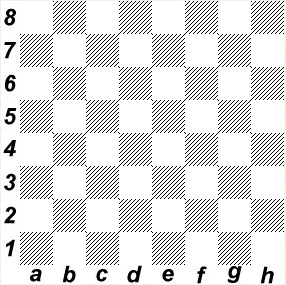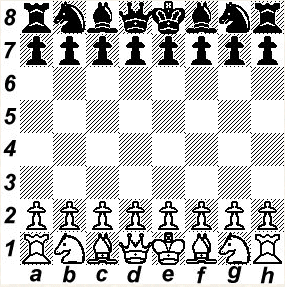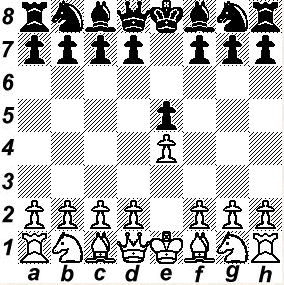
Taking Notation
Allentown Center City
Chess Club

Taking Notation
| Believe it or not, you don't have to be a scientist to learn how to take Chess Notation. Don't let the term "Algebraic Notation" scare you! Chance are, you already have the skills needed to write and use notation already! It's a very simple process. If you remember how to coordinate points on a map, then you're one step ahead of the game! |
Step One: Know the Board
Below is a picture of a chess board without the pieces. It consists of 64 alternating light and dark squares. When setting up the chess board, make sure you have it facing the right way. If your chess board is set correctly, there will ALWAYS be a light square in the bottom right hand corner. Remember this poem...White is Right.  Along the horizontal rows (from left to right) you will notice each is numbered from 1 to 8. These are called RANKS. Along the vertical columns (bottom to top) you will notice each is lettered A to H. These are called FILES. Each square on the chessboard has it's own name taken from both the rank and file it falls on. Therefore, the first square in the bottom left hand corner is called a1. Directly to that square's right is b1 and so forth. That's the whole trick. Not too hard, is it? |
Step Two: Who is Who?
|
There are two things we need to know about each piece: How do we identify it with a picture AND How do we identify it with letters (when we are writing down notation). The diagram below shows us how we identify each piece with a picture (this is called Figurative Symbols). When we write notation during a game, each piece has it's very own letter. I'm sure you could guess what they are. Since we've learned that the names of the squares are written with lower case letters, we must always write the letter designating our pieces with Capital Letters K=King Q=Queen B=Bishop N=Knight (it would make sense that "K" would be Knight, but the KING is K) R=Rook There are no letters for Pawns. If your notation only says e4, then we know a pawn moved to e4. |
Step Three: Know Your Pieces
Now let's put the pieces on the board. The White pieces always fall on the 1st and 2nd Rank. The Black pieces are always on the 7th and 8th Rank. Look at the diagram below. This is the correct way to set up the board. If you have trouble remembering which colored squares the King and Queen begin on, here's another reminder...The Queen on her color. If you have the Black pieces, your Queen is always on a dark square (with the King right beside her), and vice versa for the White Pieces.
|
Step Four: Know Special Symbols
|
During the course of any chess game, we don't just "move" pieces. We can capture, castle, check, checkmate, etc... There are special symbols that we used to help us remember what we did. Castling Kingside (or "short")= 0-0 Castling Queenside (or "long")= 0-0-0 Check= + Checkmate= ++ OR # Capture= X White Wins= 1-0 Black Wins= 0-1 Draw= 1/2-1/2 En Passant Capture= e.p. Promotion= e8=Q (or N or B or R) != Good Move !!= Excellent Move ?= Questionable Move ??= Blunder Step Five: Your Score Sheet Step Six: Putting It All Together: A Sample Game |
 |

|
|
1. e4 e5 |
2. Bc4 Bc5 |
|
|
|
|
3. Qh4 Nf6?? |
4. Qxf7# |